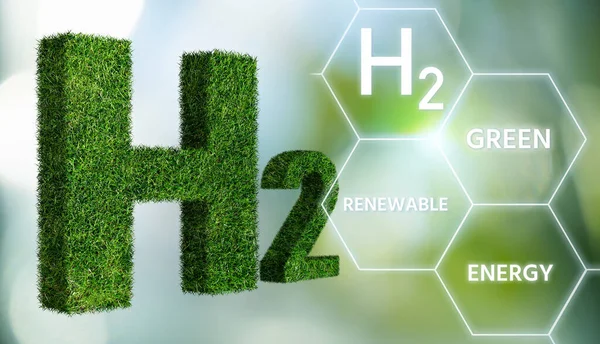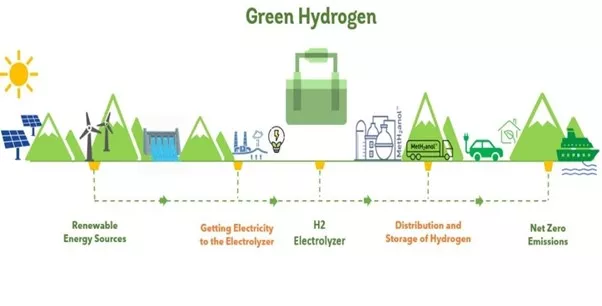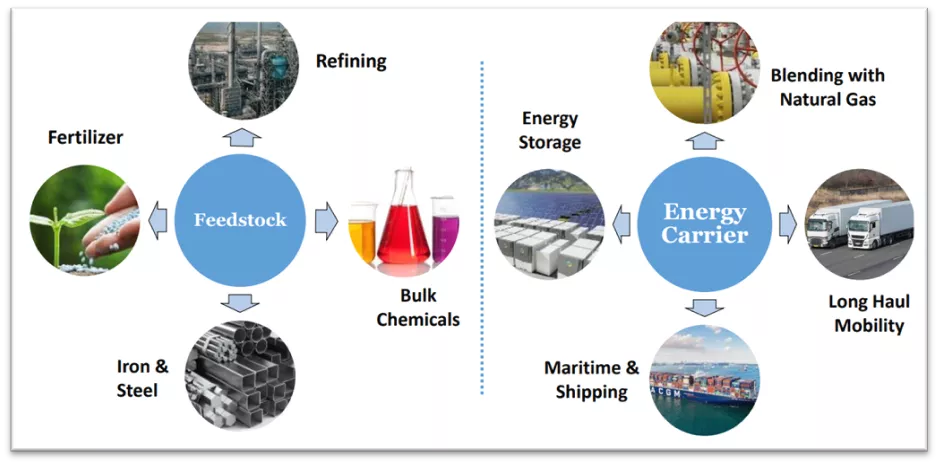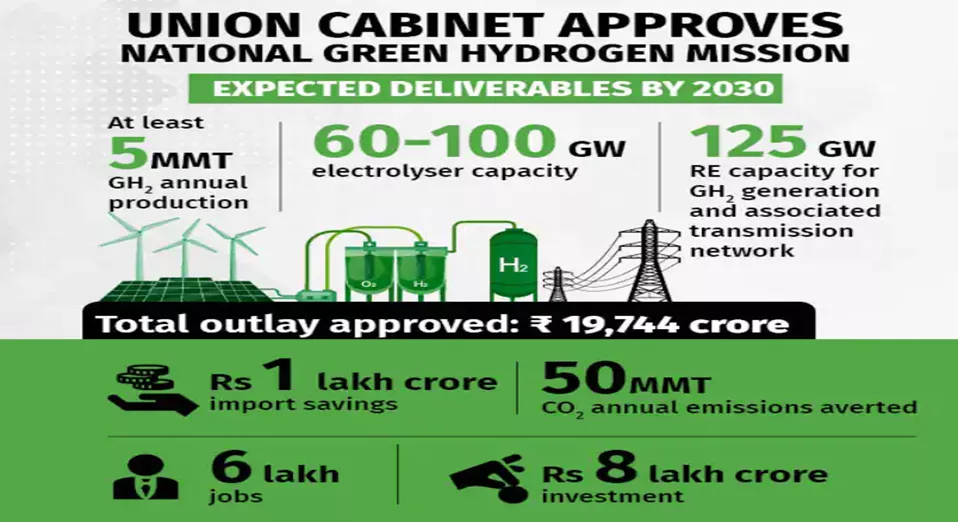Exploring The Significance And Potential Of Green Hydrogen In World’s Energy Mix

Image Source: Depositphotos
Green hydrogen is relevant, but what it really is?
By now, most of us have heard and read about green hydrogen and its sustainable impact on the global energy economy. However, only a few are aware of the reason behind its growing popularity. To understand the relevance of green hydrogen in today’s energy hungry world, it is important to peruse this wonder molecule- which is made of two bonded Hydrogen atoms. Hydrogen is the simplest and the most abundant element in the universe. It is the main ingredient for stars, the Sun, and is also the lightest element in the universe. Now here’s the catch- despite being in abundance, hydrogen is never found in pure form- as it grabs other elements with its reactive electron. Unlike fossil fuels that are obtained directly below the surface of the earth, hydrogen cannot be obtained directly in a pure form. This is one of the biggest reasons, why hydrogen had earlier lost to fossil fuels in taking center stage in the world’s energy mix.
Today’s times are different, with an impending issue of climate change and a race towards achieving net zero target, the world has realized that it has to find a sustainable alternative to fossil fuels without any further delay. What better than hydrogen, an energy source that is available in abundance, though not in pure form? Almost half of the hydrogen we utilize today comes from natural gas through a process called steam methane reforming or SMR. The problem is that SMR produces hydrogen that contains around 11 kg of C02 per kg of H2. This ‘grey hydrogen’ is therefore not very environmentally friendly.

Image Source: World Bank Blog
This is where we welcome – ‘green’ hydrogen, which is produced through the electrolysis of water by using renewable energy sources like wind, solar, or both. The carbon footprint of green hydrogen is extremely low when compared to grey. In India, hydrogen with an emission limit of 2 kg of C02 per kg of H2 is considered to be ‘green’. This limit varies across countries and regions.
What are the major applications of Green Hydrogen?
Another big reason why green hydrogen is gaining relevance is its vast application areas.

The Iron and Steel is the biggest emitter of C02 in the industrial sector. During steel production, the use of green hydrogen in the upstream process results in iron ore combining with hydrogen (instead of coal, which is used in the traditional processes as a reducing agent) to produce water (H20) instead of C02 and what we get in the end can be called ‘Green Steel’. Green steel doesn’t just exist in theory, Swedish company SSAB is all set to deliver the world’s first ‘fossil free steel’ by 2026. In fact, several major steel manufacturers have plans to decarbonize their steel making process in the next few years. In fact, green hydrogen can be used as a sustainable alternative in other steel making processes as well.
Refineries are the other big users of grey hydrogen, which is used for removing sulfur via desulfurization and is traditionally made via carbon intensive- SMR process. If this grey hydrogen is replaced by green, it can significantly reduce the refinery’s C02 emissions. It is interesting to note that Indian Oil Corporation Limited, which is one of India’s biggest refiners, has decided to convert 50% of its refinery’s hydrogen use to green by the year 2050.
To feed a bigger and wealthier global population in the next few decades, the world needs to increase its food production by more than 70%. For this, it needs to significantly increase its crop yield which means more demand for fertilizers. Ammonia is the main intermediate product that is needed for the production of all nitrogen-based fertilizers. The Haber-Bosch process is the primary method for producing ammonia from nitrogen and grey hydrogen and produces around 1.8% of the global C02 emissions. When we use green hydrogen instead of grey, what we get is green ammonia which will significantly reduce the carbon footprint of the fertilizer industry. In fact, green ammonia has several other applications, such as co-firing in power plants and fuel for ships. Green hydrogen is also used to produce bulk chemicals like e-methanol by combining it with biogenic C02.
Energy Storage is another hot sector where green hydrogen has immense potential. A huge energy demand in Europe during winter requires seasonal storage, which electricity cannot provide. This requirement can be met by green hydrogen. This requires an extensive gas grid infrastructure, which most of the countries in Europe already have. These gas grids can carry hydrogen just like natural gas and can convert it into electricity through fuel cells. A fuel cell uses the chemical energy of hydrogen to produce clean electricity and the only byproducts we get are water and heat. These fuel cells are also being used to produce fuel cell electric vehicles and hydrogen fuel cell buses. With its long range ( more than twice when compared to electric buses ) and quick refuelling time of 7-10 minutes, fuel cell buses are gaining popularity and are already operational in several European cities like Oslo and Antwerp, along with countries like China and India to name a few.
Hydrogen blending with natural gas is another emerging application area for green hydrogen. Green hydrogen can be compressed and can be transported through the conventional natural gas infrastructure (as mentioned earlier) which can make gas much cleaner and sustainable. Also, there is no need to change any equipment or pipelines when we blend hydrogen with natural gas in the range of 1-10%. However, this range varies for different countries and regions based on the technical specifications of the existing natural gas pipelines.
What’s next?
With a wide range of industrial applications and lower carbon emissions compared to grey hydrogen, green hydrogen is indeed finding a lot of takers globally.

Image Source: Moneycontrol.com
In fact, countries like India now have a ‘National Green Hydrogen Mission’ in place, which will promote the production, usage, and export of green hydrogen and its derivatives like green ammonia. In the case of Europe, the European Union ( EU) has modified its Renewable Energy Directive to increase the share of renewable energy towards its overall energy consumption to 42.5% by 2030 with an additional 2.5% indicative top up that will allow it to reach to 45%. This amendment will be supported by the production and supply of green hydrogen and its derivatives.
Counties like India can benefit from its abundant renewable energy (RE) resources and become a major producer and exporter of green hydrogen and its derivatives by focusing on localized manufacturing of key equipment like electrolysers. And things are moving in the right direction in India, one of the prime examples is that of India based- Hygenco Green Energies Private Limited, which is setting up India’s first commercial long-term offtake green hydrogen plant in Jindal Stainless, Hisar. This project will be a state-of-the-art green hydrogen facility with a target to reduce carbon emissions considerably by around 2,700 Metric Tonnes per annum.
Clear Directives and Collaboration Required
It is important to note that international standards and directives for green hydrogen and its derivatives are still evolving, and countries looking to become leaders in this space will have to comply with rules-regulations on renewable hydrogen production, which will vary from one region or country to another.
It is extremely vital for different countries and regions to collaborate, develop, and finalize common and acceptable certifications and standards for green hydrogen and its derivatives. Even carbon markets for green hydrogen and derivatives must be developed and put in place at the earliest. Developments and clarity in all these critical aspects will eventually support global trade, improve economies of scale, and finally make green hydrogen more competitive than grey in the near future.
In his concluding statement at COP28, Antonio Gutteres, UN Secretary General said “To those who opposed a clear reference to a phase out of fossil fuels in the CoP28 text, I want to say that a fossil fuel phase out is inevitable, whether they like it or not. Let’s hope it doesn’t come too late. The era of fossil fuels must end, and it must end with justice and equity”. Believe it or not, we are currently standing at a historic juncture, as the next few years will decide the fate of green hydrogen and world’s future with respect to its energy mix.
More By This Author:
Volatile Oil Prices To ContinueInfosys - Time For Another Look
Oil Prices Edge Past $45




Great read.